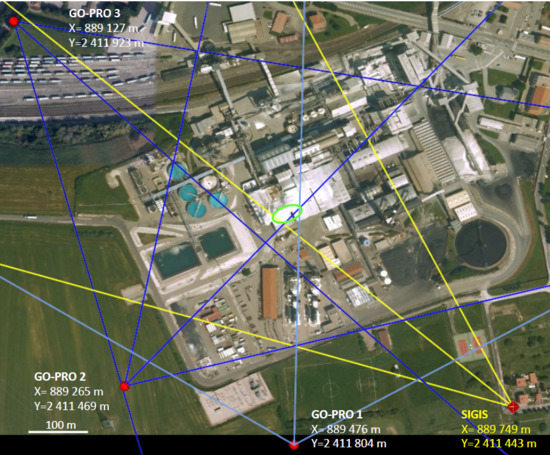Near Real-Time Ground-to-Ground Infrared Remote-Sensing Combination and Inexpensive Visible Camera Observations Applied to Tomographic Stack Emission Measurements
Abstract
:1. Introduction
- -
- from a technical point of view, there must be an inexpensive and quick remote-imaging monitoring system, easily transportable and adaptable to any type of land configuration;
- -
- from a scientific point of view, one must be able to determine the size of the column density to provide gas concentrations in ppm;
- -
- from a practical point of view, most mixed gaseous emissions have a visible atmospheric trace.
2. Material and Methods
2.1. Stereoscopic Measurements (Multi-Angles) in Real Time by Visible Cameras
2.2. Infrared (IR) Scanning System
2.3. Positioning of the Various Devices on the Industrial Site
2.4. 3-D Modeling Protocol Using the Paradigm gOcad® Software
2.4.1. Gas-Plume Reconstruction
2.4.2. 3D NH3 Concentrations within the Plume
3. Results and Discussion
3.1. Generality
3.2. Distances within the Gas Plume
3.3. Quantitative Spatial Distribution of NH3 in the Gas Plume
4. Applications to Other Types of Gas Plume
- -
- AZD Factory explosion, Toulouse 2001 France, where the visible trace is mainly associated with organic/mineral particles (Figure 10A);
- -
- volcanic eruptions where the visible trace is mainly associated with particles and water vapor, Eyjafjöll and Grimsvötn 2011 Iceland (Figure 10B);
- -
- Tianjin explosion, where the visible trace is a very complex association of particles and gases, Tianjin 2015 China (Figure 10C);
- -
- and CH4 emissions from an on-shore oil field where the visible trace is mainly associated with organic particles, California 2015–2016 (USA) (Figure 10D).
5. Conclusions
Author Contributions
Acknowledgments
Conflicts of Interest
References
- Pascal, L. Short-term health effects of air pollution on mortality. Rev. Mal. Respir. 2009, 26, 207–219. [Google Scholar] [CrossRef]
- Herget, W.F.; Brashers, J.D. Remote Fourier transform infrared air pollution studies. Opt. Eng. 1980, 19, 194508–194515. [Google Scholar] [CrossRef]
- Marshall, T.L.; Chaffin, C.T.; Hammaker, R.M.; Fately, W.G. An introduction to open-path FT-IR Atmospheric monitoring. Environ. Sci. Technol. 1994, 28, 224A–232A. [Google Scholar] [CrossRef] [PubMed]
- Beil, A.; Daum, R.; Harig, R.; Matz, G. Remote sensing of atmospheric pollution by passive FTIR spectrometry. Proc. SPIE 1998, 3493, 32–43. [Google Scholar] [CrossRef]
- Schütze, C.; Lau, S.; Reiche, N.; Sauer, U.; Borsdorf, H.; Diet, P. Ground-based remote sensing with open-path Fourier-transform infrared (OP-FTIR) spectroscopy for large-scale monitoring of greenhouse gases. Energy Procedia 2013, 37, 4276–4282. [Google Scholar] [CrossRef]
- Harig, R.; Rusch, P.; Dyer, C.; Jones, A.; Moseley, R.; Truscott, B. Remote measurement of highly toxic vapors by scanning imaging Fourier-transform spectrometry. Proc. SPIE 2005, 5995, 316–327. [Google Scholar] [CrossRef]
- Harig, R.; Matz, G.; Rusch, P.; Gerhard, H.; Gerhard, J.; Schlabs, V. Infrared remote sensing of hazardous vapours: Surveillance of public areas during the FIFA Football World Cup 2006. Proc. SPIE 2007, 6538, 65381Z:1–65381Z:10. [Google Scholar] [CrossRef]
- Bradley, K.S.; Brooks, K.B.; Hubbard, L.K.; Popp, P.J.; Stedman, D.H. Motor vehicle fleet emissions by OP-FTIR. Environ. Sci. Technol. 2000, 34, 897–899. [Google Scholar] [CrossRef]
- Burton, M.R.; Oppenheimer, C.; Horrocks, L.A.; Francis, P.W. Remote sensing of CO2 and H2O emission rates from Masaya volcano, Nicaragua. Geology 2000, 28, 915–918. [Google Scholar] [CrossRef]
- Goff, F.; Love, S.P.; Warren, R.G.; Counce, D.; Obenholzner, J.; Siebe, C.; Schmidt, S.C. Passive infrared remote sensing evidence for large intermittent CO2 emissions at Popocatépetl volcano, Mexico. Chem. Geol. 2001, 177, 133–156. [Google Scholar] [CrossRef]
- Allard, P.; Burton, M.; Muré, F. Spectroscopic evidence for a lava fountain driven by previously accumulated magmatic gas. Nature 2005, 433, 407–410. [Google Scholar] [CrossRef] [PubMed]
- Kenji, N.; Mori, T. Chemical monitoring of volcanic gas using remote FT-IR spectroscopy at several active volcanoes in Japan. Appl. Geochem. 2010, 25, 505–512. [Google Scholar] [CrossRef]
- Reiche, N.; Westerkamp, T.; Lau, S.; Borsdorf, H.; Dietrich, P.; Schütze, C. Comparative study to evaluate three ground-based optical remote sensing techniques under field conditions by a gas tracer experiment. Environ. Earth Sci. 2014, 72, 1435–1441. [Google Scholar] [CrossRef]
- La Spina, A.; Burton, M.; Allard, P.; Alparone, S.; Muré, F. Open-path FTIR spectroscopy of magma degassing processes during eight lava fountains on Mount Etna. Earth Planet. Sci. Lett. 2015, 413, 123–134. [Google Scholar] [CrossRef]
- Schütze, C.; Dietrich, P.; Schossland, A.; Möller, I.; Schlömer, S.; Martens, S.; Liebscher, A.; Möller, F.; Sauer, U. Application of monitoring methods for remote detection of atmospheric CO2-Concentration levels during a back-production test at the Ketzin Pilot Site. Energy Procedia 2015, 76, 528–535. [Google Scholar] [CrossRef]
- Harig, R.; Matz, G. Toxic cloud imaging by infrared spectrometry: A scanning FTIR system for identification and visualization. Field Anal. Chem. Technol. 2001, 5, 75–90. [Google Scholar] [CrossRef]
- Rusch, P.; Harig, R. 3-D reconstruction of gas clouds by scanning imaging IR spectroscopy and tomography. Sensors J. IEEE 2010, 10, 599–603. [Google Scholar] [CrossRef]
- De Donato, P.; Barres, O.; Sausse, J.; Taquet, N. Advances in 3-D infrared remote sensing gas monitoring. Application to an urban atmospheric environment. Remote Sens. Environ. 2016, 175, 301–309. [Google Scholar] [CrossRef]
- Thenkaball, P.S.; Enclona, E.A.; Ashton, M.S.; Legg, C.; De Dieu, M.J. Hyperion, IKONOS, ALI, and ETM+ sensors in the study of African rainforests. Remote Sens. Environ. 2004, 90, 23–43. [Google Scholar] [CrossRef]
- Plaza, A.; Benediktsson, J.A.; Boardman, J.W.; Brazile, J.; Bruzzone, L.; Camps-Valls, G.; Chanussot, J.; Fauvel, M.; Gamba, P.; Gualtieri, A.; et al. Recent advances in techniques for hyperspectral image processing. Remote Sens. Environ. 2009, 113 (Suppl. 1), S110–S122. [Google Scholar] [CrossRef]
- Gao, B.-C.; Li, R.-R.; Shettle, E.P. Cloud remote sensing using midwave IR CO2 and N2O slicing channels near 4.5 μm. Remote Sens. 2011, 3, 1006–1013. [Google Scholar] [CrossRef]
- Lorenz, S.; Salehi, S.; Kirsch, M.; Zimmermann, R.; Unger, G.; Vest Sørensen, E.; Gloaguen, R. Radiometric correction and 3D integration of long-range ground-based hyperspectral imagery for mineral exploration of vertical outcrops. Remote Sens. 2018, 10, 176. [Google Scholar] [CrossRef]
- Todd, L.A.; Ramanathan, M.; Mottus, K.; Katz, R.; Dodson, A.; Mihlan, G. Measuring chemical emissions using open-path Fourier transform infrared (OP-FTIR) spectroscopy and computer-assisted tomography. Atmos. Environ. 2001, 35, 1937–1947. [Google Scholar] [CrossRef]
- Schowengerdt, R.A. Remote Sensing: Models and Methods for Image Processing, 3rd ed.; Academic Press Elsevier: Burlington, MA, USA, 2007; 560p, ISBN 9780123694072. [Google Scholar]
- Brito Junior, A.M.; Neto, A.D.D.; de Melo, J.D.; Goncalves, L.M.G. An adaptive learning approach for 3-D surface reconstruction from point clouds. Neural Netw. Council 2008, 19, 1130–1140. [Google Scholar] [CrossRef] [PubMed]
- Ricciardelli, E.; Romano, F.; Cuom, V. Physical and statistical approaches for cloud identification using Meteosat Second Generation-Spinning Enhanced Visible and Infrared Imager Data. Remote Sens. Environ. 2008, 112, 2741–2760. [Google Scholar] [CrossRef]
- Schneider, A.; Friedl, M.A.; Potere, D. Mapping global urban areas using MODIS 500-m data: New methods and datasets based on urban ecoregions. Remote Sens. Environ. 2010, 114, 1733–1746. [Google Scholar] [CrossRef]
- Liua, B.; Chena, X.G.; Guoa, L.P.; Yub, X.Q. A MPB-based remote sensing image 3-D reconstruction system. Optik 2015, 126, 1994–1998. [Google Scholar] [CrossRef]
- Zhang, W.; Sunb, X.; Wangb, H.; Fu, K. A generic discriminative part-based model for geospatial object detection in optical remote sensing images. ISPRS J. Photogramm. Remote Sens. 2015, 99, 30–44. [Google Scholar] [CrossRef]
- Mallet, J.L. Discrete smooth interpolation in geometric modeling. Comput. Aided Des. 1992, 24, 178–191. [Google Scholar] [CrossRef]
- Mallet, J.L. Discrete modeling for natural objects. Math. Geol. 1997, 29, 199–219. [Google Scholar] [CrossRef]
- Mallet, J.L. Geomodeling. In Applied Geostatistics; Oxford University Press: New York, NY, USA, 2002; ISBN 0-19-514460. [Google Scholar]
- Harig, R. Passive remote sensing of pollutants clouds by Fourier transform infrared spectrometry: Signal to noise ratio as a function of spectral resolution. Appl. Opt. 2004, 43, 4603–4610. [Google Scholar] [CrossRef] [PubMed]
- Caumon, G.; Collon-Drouaillet, P.; Le Carlier de Veslud, C.; Viseur, S.; Sausse, J. Surface-based 3D modeling of geological structures. Math. Geosci. 2009, 41, 927–945. [Google Scholar] [CrossRef]
- Houlton, B.Z.; Morford, S.L.; Dahlgren, R.A. Convergent evidence for widespread rock nitrogen sources in Earth’s surface environment. Science 2018, 360, 58–62. [Google Scholar] [CrossRef] [PubMed]
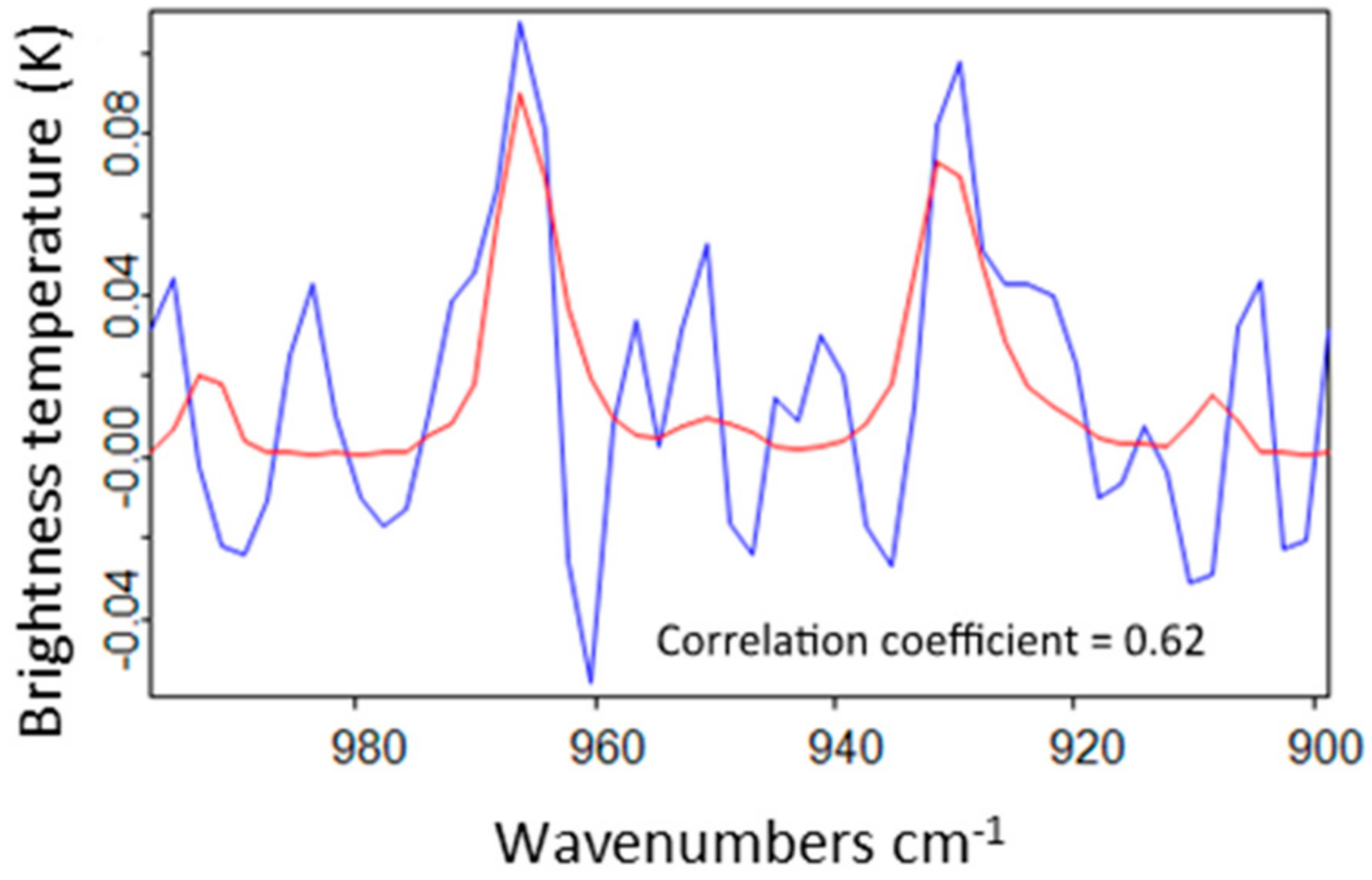
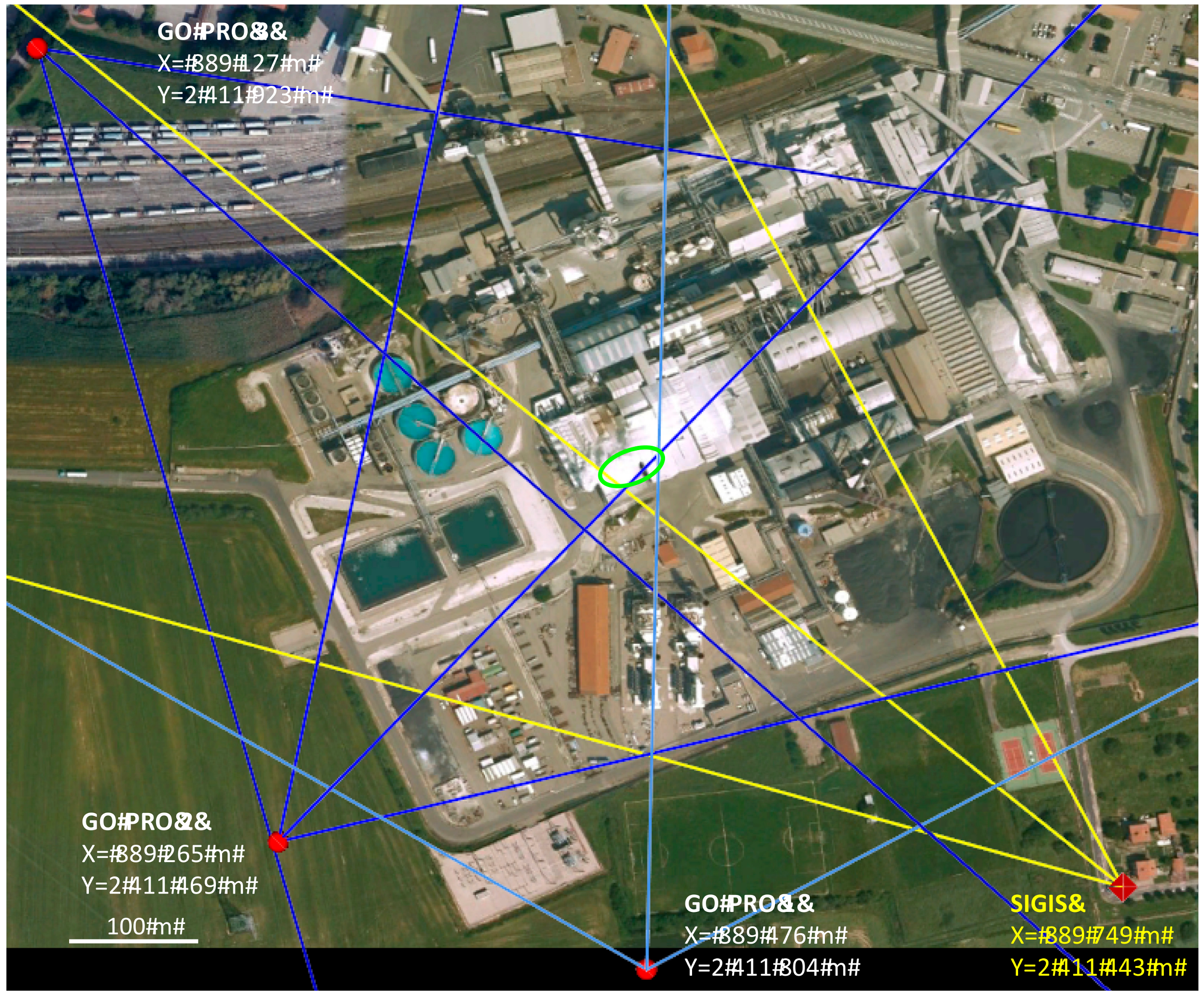
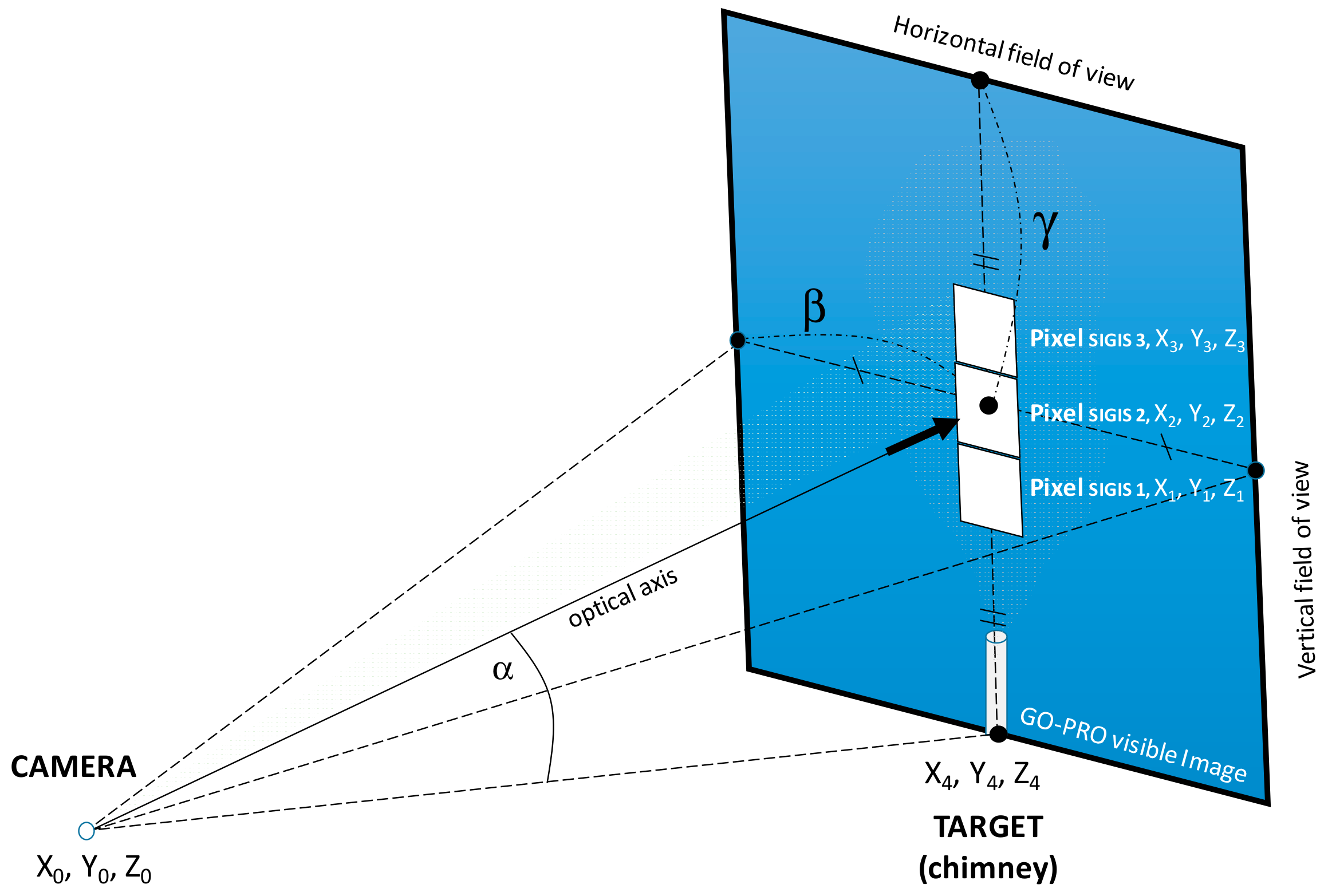
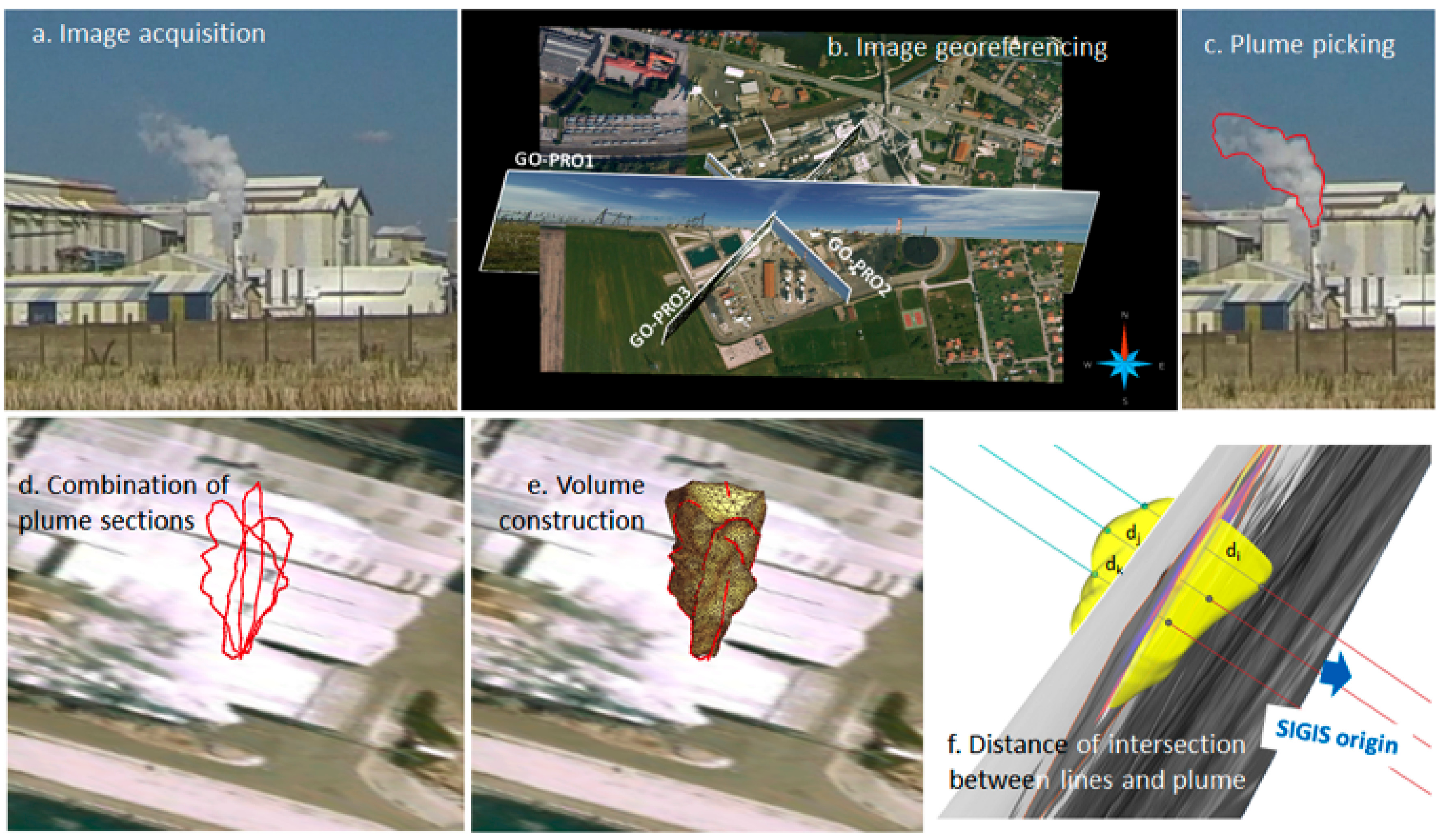
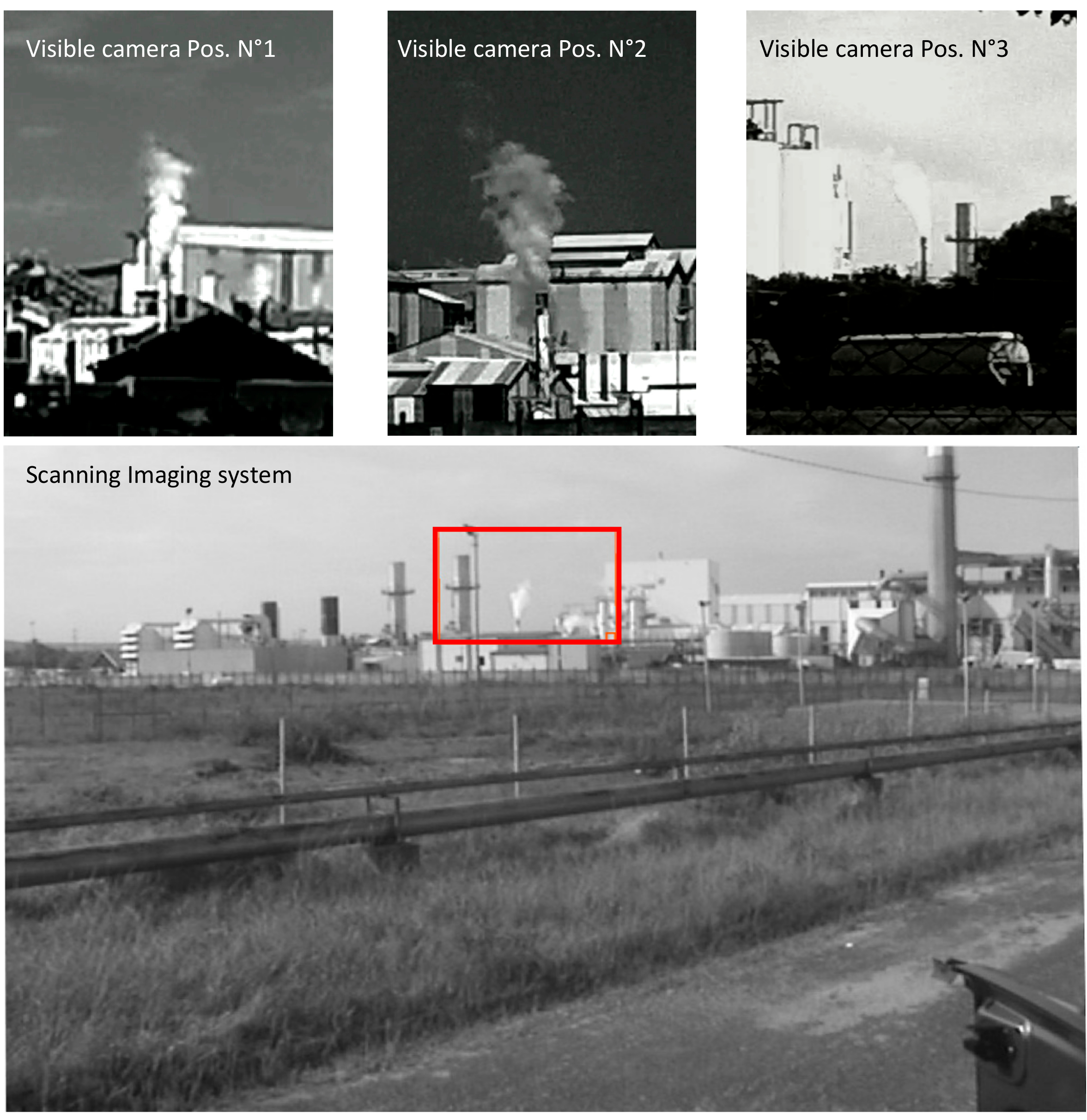
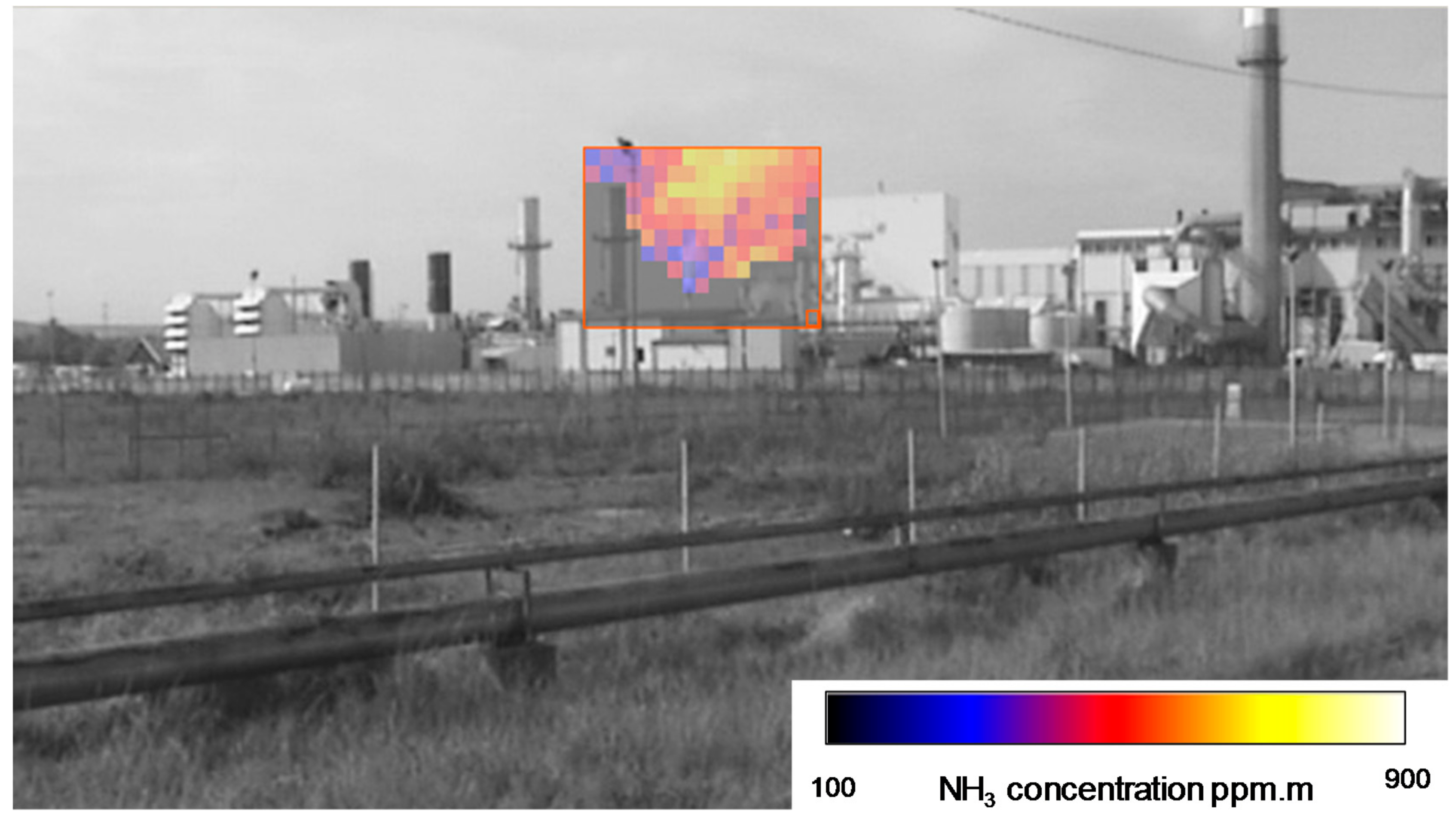
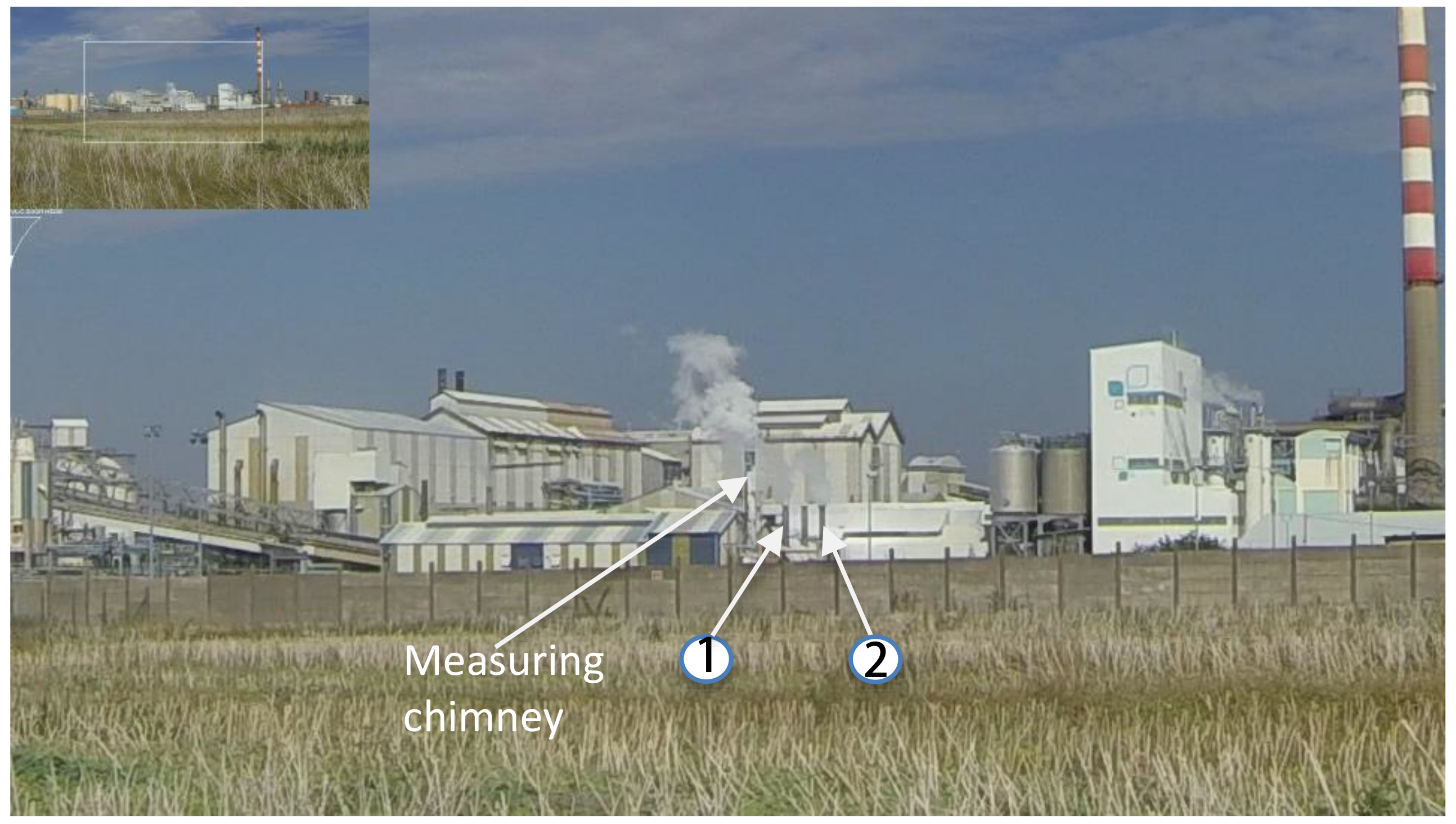
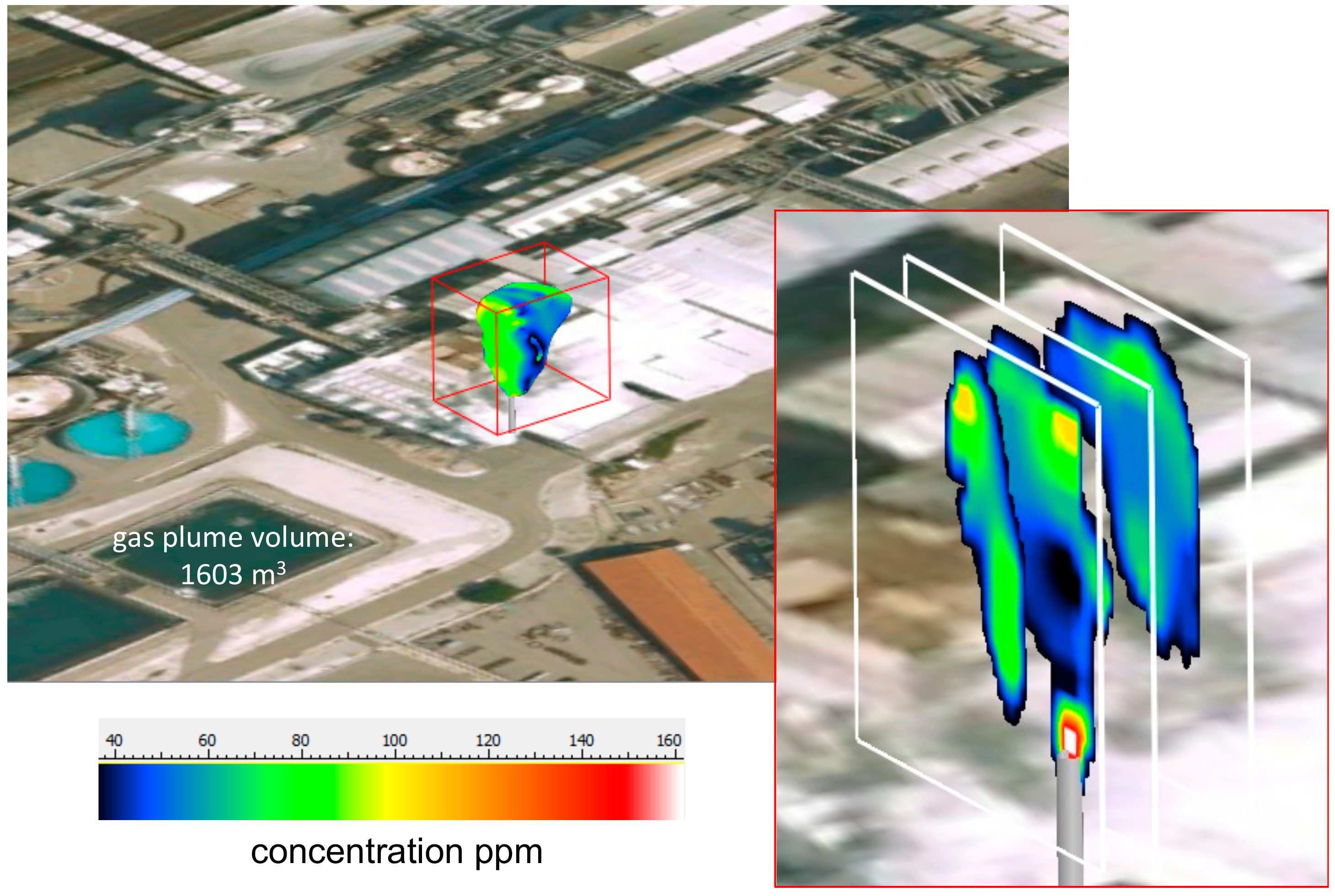
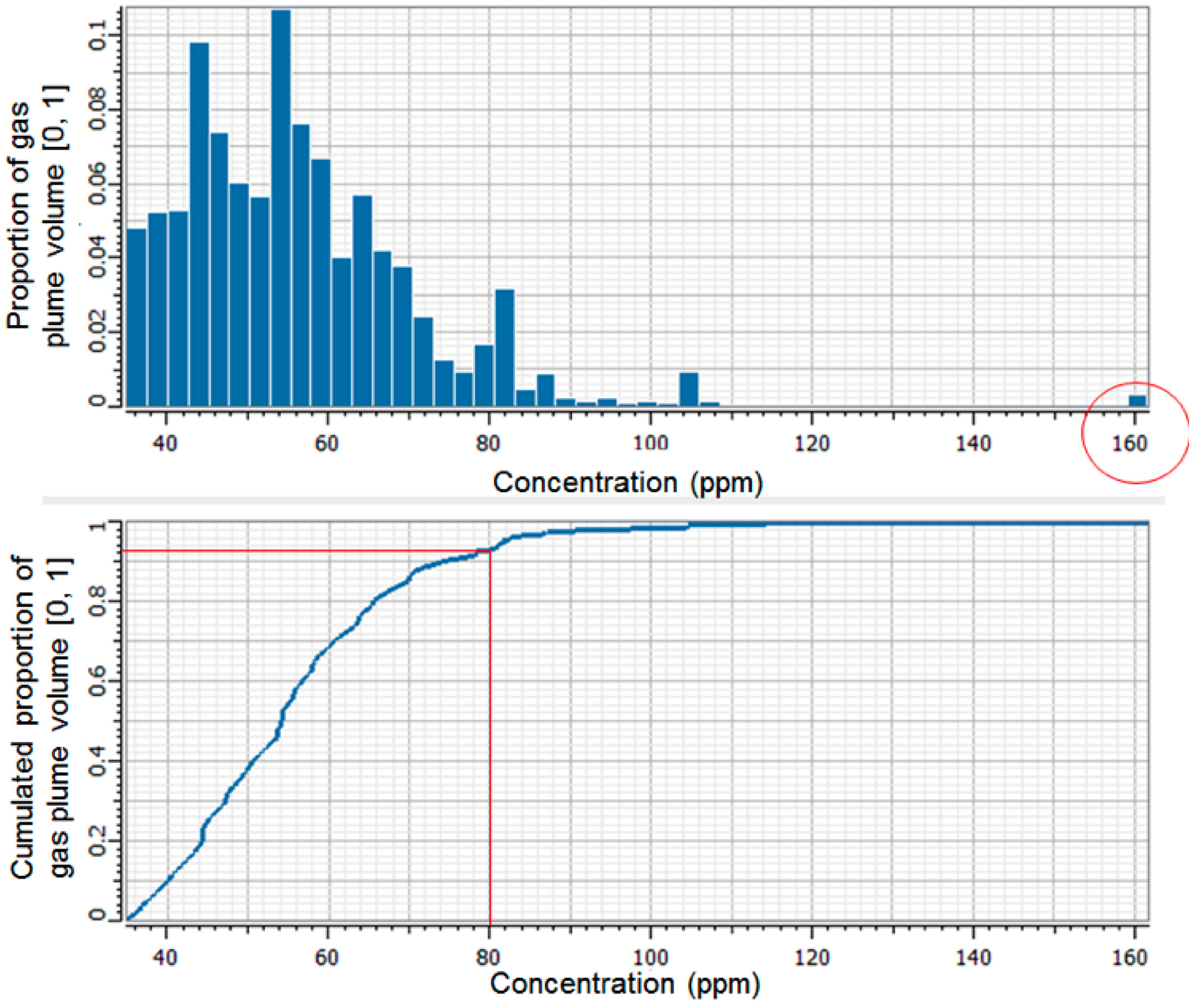
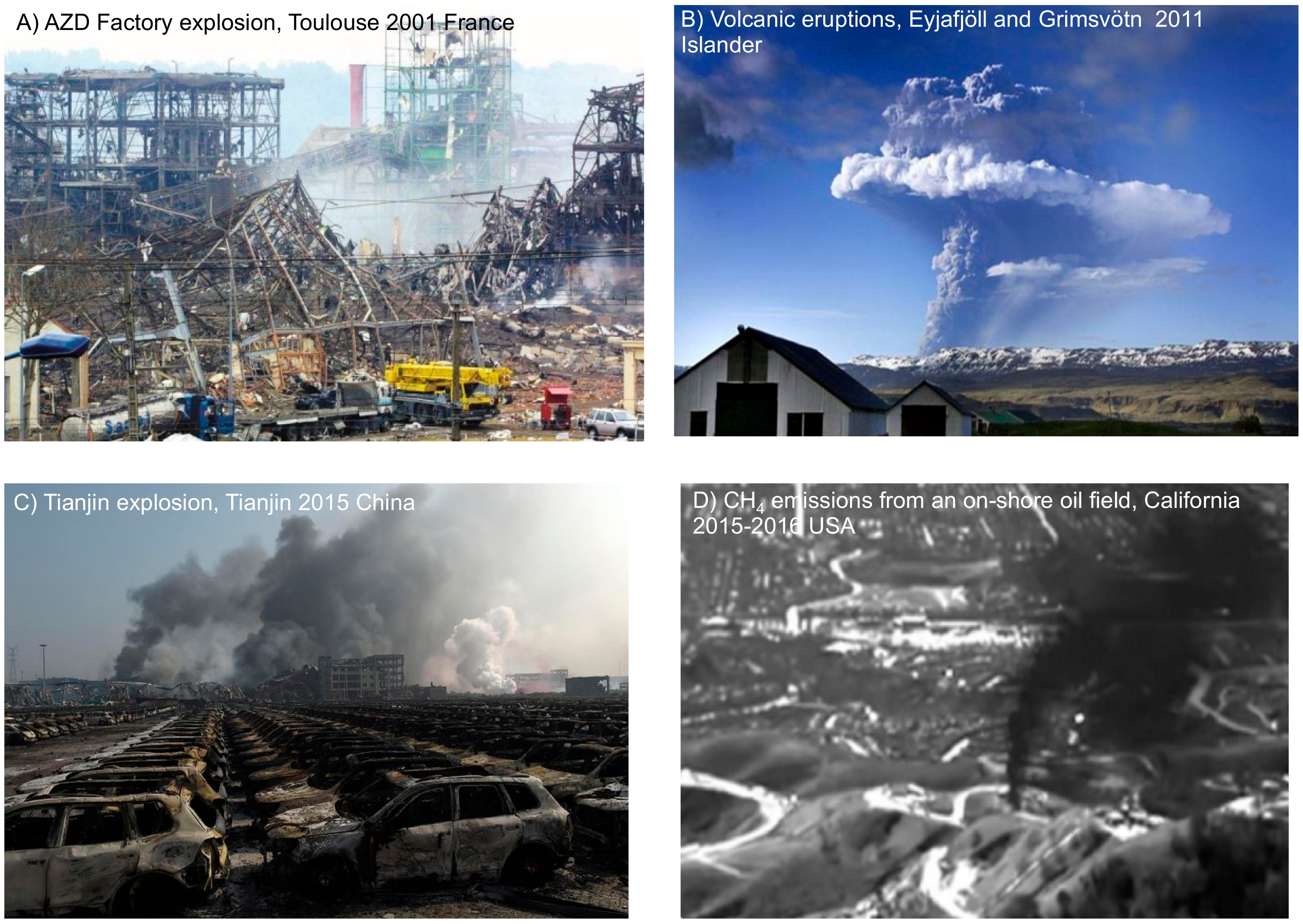
| Resolution (pixels) | Fps (Images/s) | FOV (Field of View) | Size Screen | Horizontal Angle of Opening * | Vertical Angle of Opening (Azimuth) * |
|---|---|---|---|---|---|
| 1920 × 1440 GoPro 1 | 48 | Narrow | 4:3 | 122.6° | 94.4° |
| 1920 × 1080 GoPro 2 and 3 | 48 | Narrow | 16:9 | 64.4° | 37.2° |
| Parameter | Value/Type |
|---|---|
| Interferometer type | Bruker OPAG 33 |
| Spectral range | 3900–600 cm−1 |
| NH3 detection window | 1050–900 cm−1 |
| Spectral resolution | 4 cm−1 |
| Apodization function | Triangular |
| Zero filling | 1 |
| Phase correction | Power spectrum |
| Maximum spectral rate (Resolution: 4 cm−1) | 16 spectra/s |
| Field of view | 10 mrad |
| Maximal horizontal field of regard | 360° |
| Maximal vertical field of regard | 60° |
| Horizontal field of view (SIGIS visible camera) | 46° |
| Vertical field of view (SIGIS visible camera) | 30° |
| Number of pixels in a measurement grid | 187 (17 × 11) |
| Acquisition time for one grid (s) | 23 |
| Type | Global Positioning System (GPS) Coordinates | GPS Altitude (m) | Horizontal Tilt (°) | Tilt of the Optical Axis (°) |
|---|---|---|---|---|
| SIGIS BRUKER | N 48°38’11.1” O 06°15’04.4” X = 889,749 m Y = 2,411,443 m | 222 | 0 | 0 |
| Camera GoPro Position 1 | N 48°38’10.0” O 06°15’51.1” X = 889,476 m Y = 2,411,804 m | 226 | 0 | 2.3 |
| Camera GoPro Position 2 | N 48°38’12.7” O 06°15’40.8” X = 889,265 m Y = 2,411,469 m | 226 | 0 | 1.7 |
| Camera GoPro Position 3 | N 48°38’27.6” O 06°15’35.2” X = 889,127 m Y = 2,411,923 m | 213 | −4.6 | 0.6 |
| Data | Starting Time 1:40 p.m. (GMT) | Ending Time 1:55 p.m. (GMT) |
|---|---|---|
| Atmospheric CO2 (ppm) | 416 | 396 |
| Temperature (°C) | 31 | 31 |
| Relative humidity (%) | 34 | 33 |
| Atmospheric pressure (hPa) | 1015 | 1015 |
| Wind velocity (km/h) | 4 | 15 |
| Wind direction (°) | 210 | 180 |
| Visibility (km) | 35 | 18 |
| Precipitation (mm/h) | 0 | 0 |
| Intersection Distance (m) | Concentration (ppm) | |||
|---|---|---|---|---|
| ppm.m | ||||
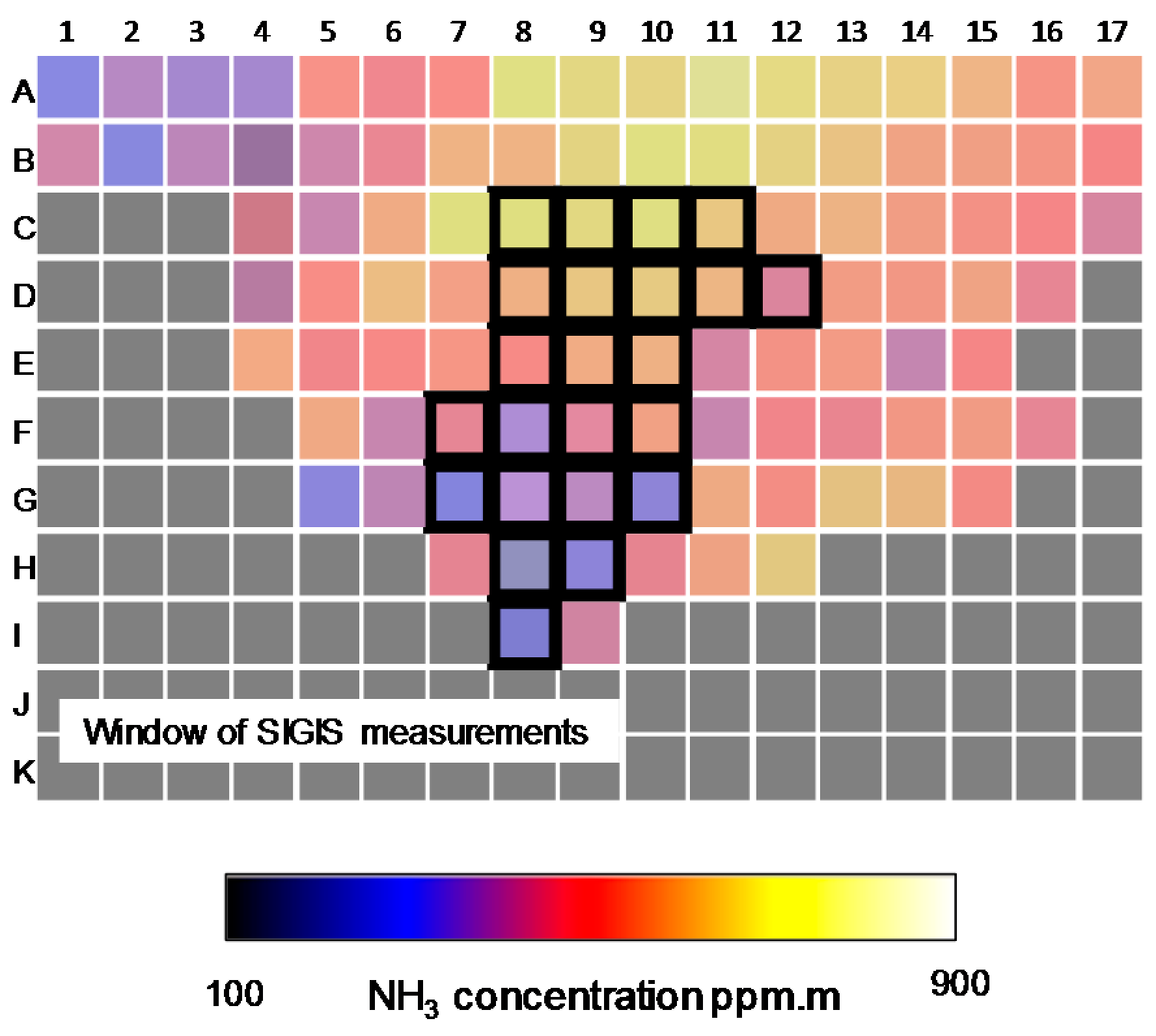 | C8 | 699 | 6.68 | 104.61 |
| C9 | 687 | 9.80 | 70.08 | |
| C10 | 707 | 8.75 | 80.79 | |
| C11 | 647 | 8.26 | 78.33 | |
| D8 | 594 | 7.28 | 81.61 | |
| D9 | 647 | 11.16 | 57.99 | |
| D10 | 658 | 12.14 | 54.21 | |
| D11 | 611 | 12.91 | 47.31 | |
| D12 | 451 | 8.34 | 54.06 | |
| E8 | 511 | 8.01 | 63.80 | |
| E9 | 586 | 10.54 | 55.60 | |
| E10 | 598 | 11.17 | 53.55 | |
| F7 | 469 | 5.67 | 82.75 | |
| F8 | 351 | 10.02 | 35.02 | |
| F9 | 452 | 10.18 | 44.38 | |
| F10 | 567 | 8.65 | 65.54 | |
| G7 | 299 | 3.43 | 87.21 | |
| G8 | 364 | 8.22 | 44.28 | |
| G9 | 385 | 8.67 | 44.39 | |
| G10 | 319 | 5.03 | 63.42 | |
| H8 | 192 | 5.23 | 36.69 | |
| H9 | 316 | 4.48 | 70.58 | |
| I8 | 305 | 1.89 | 161.71 |
| Distance (m) | Concentration (ppm) | |||
|---|---|---|---|---|
| Raw Volume | Interpolated Volume | Raw Volume | Interpolated Volume | |
| mean | 8.1 | 6.9 | 66.9 | 81.0 |
| standard deviation | 2.8 | 3.0 | 26.5 | 36.5 |
| min | 1.89 | 0.8 | 35.02 | 39.7 |
| max | 12.91 | 12.2 | 161.71 | 170.3 |
© 2018 by the authors. Licensee MDPI, Basel, Switzerland. This article is an open access article distributed under the terms and conditions of the Creative Commons Attribution (CC BY) license (http://creativecommons.org/licenses/by/4.0/).
Share and Cite
De Donato, P.; Barres, O.; Sausse, J.; Martin, D. Near Real-Time Ground-to-Ground Infrared Remote-Sensing Combination and Inexpensive Visible Camera Observations Applied to Tomographic Stack Emission Measurements. Remote Sens. 2018, 10, 678. https://doi.org/10.3390/rs10050678
De Donato P, Barres O, Sausse J, Martin D. Near Real-Time Ground-to-Ground Infrared Remote-Sensing Combination and Inexpensive Visible Camera Observations Applied to Tomographic Stack Emission Measurements. Remote Sensing. 2018; 10(5):678. https://doi.org/10.3390/rs10050678
Chicago/Turabian StyleDe Donato, Philippe, Odile Barres, Judith Sausse, and Delphine Martin. 2018. "Near Real-Time Ground-to-Ground Infrared Remote-Sensing Combination and Inexpensive Visible Camera Observations Applied to Tomographic Stack Emission Measurements" Remote Sensing 10, no. 5: 678. https://doi.org/10.3390/rs10050678
APA StyleDe Donato, P., Barres, O., Sausse, J., & Martin, D. (2018). Near Real-Time Ground-to-Ground Infrared Remote-Sensing Combination and Inexpensive Visible Camera Observations Applied to Tomographic Stack Emission Measurements. Remote Sensing, 10(5), 678. https://doi.org/10.3390/rs10050678



